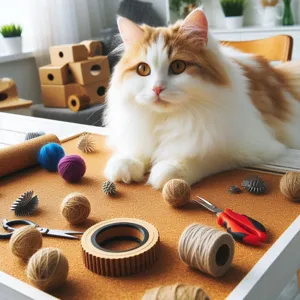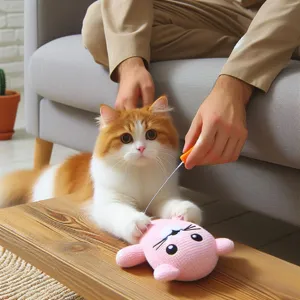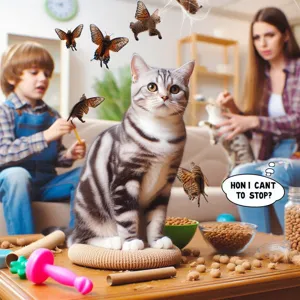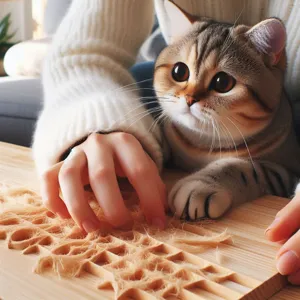As a proud cat owner, you know that your feline friend brings joy, companionship, and a sprinkle of mischief to your home.
However, one of the most common challenges that comes with kitty companionship is their relentless scratching behavior, often targeting your beloved furniture. Not only can this lead to unsightly damage, but it can also become a source of frustration for both you and your pet. The good news is that there are effective strategies to redirect your cat’s natural instincts away from your furniture and towards more appropriate scratching surfaces. In this blog post, we’ll explore ten practical and effective strategies that will help you maintain your stylish living space while keeping your cat happy and engaged. From choosing the right scratching posts to creating a stimulating environment, these tips will transform your home into a scratch-free haven where both you and your furry friend can thrive.
1. Understanding Your Cat’s Scratching Behavior

Understanding your cat’s scratching behavior is the first step in addressing this common issue. Cats are natural scratchers; it’s an instinctual behavior that serves several important purposes. When your feline friend drags their claws across your favorite armchair or couch, they are not merely acting out or being destructive. Instead, they’re fulfilling a deep-rooted need to mark their territory, stretch their muscles, and maintain their claws.
Scratching is a way for cats to establish their presence in a space. They have scent glands in their paws that release pheromones when they scratch, leaving their unique signature on their territory. This is especially crucial in multi-pet households where cats may feel the need to assert themselves. Additionally, scratching helps cats shed the outer layers of their claws, keeping them healthy and sharp.
It’s also worth noting that scratching is a natural behavior that provides physical and mental stimulation. Cats are wired to scratch, and when they don’t have appropriate outlets for this behavior, they may resort to your furniture as a makeshift scratching post. By understanding the underlying reasons behind your cat’s scratching, you can better address the behavior and provide suitable alternatives that satisfy their instinctual needs.
So, before you reach for the spray bottle or consider declawing—which is both painful and often leads to behavioral issues—take a moment to observe your cat’s habits. This insight will empower you to implement effective strategies that not only protect your furniture but also ensure your cat’s well-being.
2. The Importance of Providing Scratching Alternatives
Providing scratching alternatives is one of the most effective strategies for redirecting your cat’s natural instincts away from your furniture and onto more appropriate surfaces. Cats have an innate need to scratch; it helps them maintain healthy claws, stretch their muscles, and mark their territory. Understanding this behavior is key to keeping both your feline friend and your furniture happy.
When considering scratching alternatives, variety is crucial. Cats can be quite particular about their preferences, so offering a range of options will increase the chances of finding a suitable scratching post. Look for posts that vary in height, texture, and material. Sisal-wrapped posts, corrugated cardboard pads, and carpet-covered surfaces all appeal to different scratching styles. Some cats may prefer a vertical post they can climb, while others might enjoy a horizontal surface they can dig their claws into.
Location also plays a significant role in how successful your scratching alternatives will be. Place these posts in areas where your cat already enjoys scratching or lounging. For instance, if you notice your cat scratching the corner of your couch, position a scratching post nearby to provide an appealing alternative. You can also sprinkle catnip on the new scratching posts or pads to attract their attention and encourage use.
Additionally, consider incorporating interactive scratching options, like scratching mats or toys with built-in scratching surfaces. These can engage your cat’s playfulness while satisfying their need to scratch, making them less likely to target your furniture.
By providing a variety of well-placed scratching alternatives, you not only protect your furniture but also enrich your cat’s environment, allowing them to express their natural behaviors in a constructive way. Remember, patience and consistency are key; it may take some time for your cat to fully embrace their new scratching options, but with a little effort, you can create a harmonious living space for both of you.
3. Choosing the Right Scratching Post

Choosing the right scratching post is essential for redirecting your cat’s natural scratching instincts away from your beloved furniture. Not all scratching posts are created equal, and understanding your cat’s preferences can make all the difference in successfully protecting your home while keeping your feline friend happy.
When selecting a scratching post, consider the materials used. Cats typically prefer sisal rope, cardboard, or carpet, as these textures closely mimic the natural surfaces they would encounter in the wild. A sturdy sisal-wrapped post offers durability and resistance to wear, while a cardboard option can provide an irresistible surface for your kitty to sink their claws into. Pay attention to your cat’s scratching habits—do they prefer vertical or horizontal surfaces? If your cat enjoys scratching vertically, a tall, sturdy post that doesn’t wobble will be more attractive, allowing them to stretch and fully engage their muscles. Conversely, if they favor horizontal scratching, look for wide, flat surfaces or mats that give them ample room to scratch comfortably.
Height is another crucial factor. Cats love to stretch their bodies and claws, so a post that is at least three feet tall can entice them to scratch rather than your couch. Additionally, incorporating a variety of scratching posts around your home can cater to different preferences, ensuring your cat finds the perfect spot for their scratching sessions.
Placement is equally important. Position the scratching post near the furniture they frequently scratch or in their favorite lounging areas to encourage use. If they can easily access the post after waking up or playing, they’re more likely to utilize it instead of your furniture.
Lastly, consider enriching the scratching post with catnip or toys to make it even more appealing. A little sprinkle of catnip can turn a simple scratching post into an exciting playground, attracting your cat’s attention and encouraging them to scratch there instead.
By choosing the right scratching post that aligns with your cat’s natural instincts and preferences, you can create an inviting alternative that helps protect your furniture while ensuring your furry companion has a designated space to scratch, stretch, and play.
4. Using Cat Repellents to Protect Furniture
Using cat repellents to protect furniture can be a game-changer in your battle against kitty claws. Cats are naturally inclined to scratch, an instinctive behavior that serves to keep their claws healthy and mark their territory. However, when that territory encroaches on your favorite sofa or dining chairs, it can lead to frustration. Enter cat repellents – a strategic solution that can deter your feline friend from turning your furniture into their scratching post.
There are various types of cat repellents available on the market, including sprays, granules, and even motion-activated devices. Most sprays are formulated with natural ingredients, such as citrus or vinegar, which cats find unappealing. Simply apply these repellents to the areas you want to protect, and watch as your cat steers clear. Granules can be sprinkled around furniture legs, providing a tactile deterrent that often makes cats think twice before approaching.
For a more high-tech approach, consider motion-activated devices that emit a harmless burst of air or sound when your cat gets too close. These devices can be particularly effective because they startle your cat without causing harm, helping to reinforce the idea that certain areas are off-limits.
It’s important to note that while repellents can be effective, they work best in conjunction with other strategies. Pairing repellents with positive reinforcement – such as rewarding your cat when they use their designated scratching post – will help create a comprehensive approach to training. By using cat repellents as part of your strategy, you can protect your furniture while ensuring your furry friend still has a safe and satisfying outlet for their scratching needs.
5. Training Techniques to Discourage Scratching

Training your feline friend to stop scratching your beloved furniture can be a rewarding endeavor, requiring patience and consistency. Cats, by nature, have an instinct to scratch as a means of marking territory, stretching their muscles, and keeping their claws healthy. However, with a few effective training techniques, you can redirect this behavior towards more appropriate outlets.
Start by creating a positive association with designated scratching posts. Choose sturdy, attractive options that mimic the textures of your furniture, such as sisal-covered or cardboard posts. Place these posts near the areas your cat typically scratches. When you catch your cat using the post, shower them with praise or a small treat to reinforce the behavior. This not only encourages them to scratch in the right place but also builds a positive connection with their new post.
In addition to positive reinforcement, consider using deterrents. There are various sprays available that have unpleasant scents for cats, which can be applied to your furniture to discourage scratching. Alternatively, you can cover the furniture with protective materials like slipcovers or double-sided tape, which feels uncomfortable for cats when they attempt to scratch.
Consistency is key in training. If your cat scratches the furniture, gently redirect them to the scratching post immediately. Avoid yelling or physical reprimands; instead, use a soft voice to guide them to the appropriate spot. Over time, with persistence and encouragement, your cat will learn that the scratching post is their best option, and your furniture will remain scratch-free.
Finally, keep in mind that regular playtime can also help reduce your cat’s desire to scratch. Engaging them with interactive toys can provide the physical and mental stimulation they need, making them less likely to resort to scratching out of boredom. With these training techniques in place, you’ll foster a harmonious environment where both you and your cat can thrive together.
6. Regular Nail Trimming: A Practical Approach
Regular nail trimming is a practical yet often overlooked strategy in the battle against furniture scratching. Keeping your cat’s claws short not only minimizes the damage done to your upholstery but also contributes to their overall health and comfort. Long nails can lead to discomfort and even injury, as they can snag on fabrics or surfaces, causing painful tearing or splitting.
To start, introduce your cat to the nail trimming process gradually. Use a pair of high-quality cat nail clippers and ensure your feline friend is in a calm state—perhaps after a good play session or during a cozy cuddle. Begin by gently handling their paws, allowing them to become accustomed to the sensation. Reward them with treats and affection to create a positive association with the process.
Aim to trim just the sharp tip of the claw, avoiding the quick, which is the pinkish area that contains blood vessels and nerves. If you’re unsure, seek guidance from your veterinarian or a professional groomer. They can demonstrate the technique and help you feel more confident in your ability to maintain your cat’s nails at home.
To make nail trimming a regular part of your pet care routine, consider setting a schedule—every few weeks is typically ideal. If your cat resists, try breaking the process into smaller sessions, trimming just one or two nails at a time. Over time, your cat will likely become more accustomed to the routine, making it easier and less stressful for both of you.
In addition to protecting your furniture, regular nail trimming can also encourage your cat to engage more with scratching posts. Cats instinctively scratch to keep their claws healthy, so ensuring their nails aren’t overgrown can help redirect their natural behavior away from your beloved couch and onto appropriate surfaces. By incorporating this simple yet effective strategy, you’ll not only preserve your furniture but also foster a happier, healthier environment for your furry companion.
7. Covering Furniture with Protective Fabrics

One of the most effective strategies to deter your feline from scratching your beloved furniture is to cover it with protective fabrics. This approach serves a dual purpose: it not only safeguards your furniture but also provides a visually appealing way to maintain your home’s aesthetic.
Consider using durable, cat-friendly materials such as slipcovers, throws, or specially designed furniture protectors. Look for fabrics that are thick and textured, as these can create a less appealing surface for your cat to scratch. Options like canvas, denim, or synthetic blends are great choices, as they can withstand the claws of your furry friend while still looking stylish.
Additionally, you can find furniture covers that are specifically marketed as pet-proof. These often come with features like water resistance and easy-clean properties, making them ideal for households with active cats. Choose colors and patterns that complement your existing decor, ensuring that the protective layer enhances rather than detracts from your living space.
Moreover, layering your furniture with these protective fabrics can provide a tactile barrier that may discourage scratching. You can even sprinkle some catnip on the coverings or use pheromone sprays to create a more inviting alternative for your kitty.
By implementing this strategy, you not only protect your furniture but also send a clear message to your cat that scratching elsewhere is preferable. With time and patience, you can train your pet to respect the boundaries of your home while still allowing them to engage in their natural scratching behavior on the appropriate surfaces.
8. Creating a Cat-Friendly Environment
Creating a cat-friendly environment is a pivotal strategy in curbing unwanted scratching behavior. Cats are natural climbers and scratchers, driven by their instincts to mark territory, sharpen claws, and stretch their muscles. When you provide a space that caters to their needs, you’re not just reducing the likelihood of furniture damage—you’re enriching their lives and ensuring their happiness.
Start by designating specific areas in your home for scratching and climbing. Invest in a variety of scratching posts and pads made from different materials, such as sisal, cardboard, or carpet. Place these alternatives near the furniture your cat tends to target. Cats often scratch after waking up, so positioning a scratching post near their favorite napping spot can encourage them to use it instead of your precious couch.
In addition to scratching posts, consider adding vertical spaces like cat trees or shelves. Cats crave height, as it gives them a sense of security and a perch from which to survey their territory. Creating a multi-level environment not only deters scratching on furniture but also provides your kitty with an engaging space to explore and play.
Don’t forget to enrich your home with toys and interactive elements. Toys that mimic prey, like feather wands or laser pointers, can keep your cat entertained and distracted from your furniture. Puzzle feeders can also stimulate their minds while reducing boredom, another common trigger for scratching.
Finally, ensure that your cat feels secure in their environment. Create cozy hideaways with blankets or cat beds in quiet corners, away from the hustle and bustle of daily life. A calm and comfortable cat is less likely to engage in destructive behaviors, leading to a harmonious home where both you and your feline companion can thrive. By thoughtfully designing a cat-friendly environment, you not only protect your furniture but also foster a happy and fulfilled pet.
9. Rewarding Positive Behavior: Reinforcement Strategies
When it comes to curbing your cat’s scratching habits, positive reinforcement is one of the most effective strategies you can employ. Cats, like many animals, respond well to encouragement and rewards, making it essential to highlight and celebrate their good behavior. By focusing on rewarding the actions you want to see, rather than simply punishing unwanted behavior, you can create a nurturing environment that encourages your feline friend to use their designated scratching posts instead of your beloved furniture.
Start by observing your cat’s behavior closely. When you catch them scratching their scratching post or any other appropriate surface, immediately offer praise in a cheerful voice. Use treats, such as tasty morsels of their favorite cat food or small bits of freeze-dried meat, as incentives. This can be a powerful motivator, as cats are often food-driven. Try to give the reward within a few seconds of the desired behavior to help them associate the action with the positive reinforcement.
Incorporating playtime into your reinforcement strategy can also be beneficial. If your cat transitions from scratching furniture to their post, engage them in a fun game with a wand toy or laser pointer as a reward. This not only reinforces their good choice but also strengthens the bond between you and your pet while providing them with the physical exercise they need.
Consistency is key in this process. Make sure everyone in the household is on the same page regarding rewards, ensuring that your cat receives uniform feedback regardless of who is present. As your cat begins to understand that scratching the post leads to positive outcomes, they will gradually shift their behavior, allowing you to reclaim your furniture without the need for aggressive tactics. With patience and perseverance, you’ll soon see your cat embracing their scratching post as their new favorite spot, leading to a harmonious home for both of you.
10. Redirecting Scratching to Appropriate Surfaces
Redirecting scratching to appropriate surfaces is not just a solution; it’s an art form that requires patience, observation, and a little creativity. Cats have an innate urge to scratch, which serves multiple purposes: it helps them shed old claws, stretch their muscles, and mark their territory. As a cat owner, your goal is to channel this instinct in a way that spares your furniture from damage while ensuring your feline friend remains happy and healthy.
Start by introducing a variety of scratching posts made from different materials—like sisal, cardboard, or carpet—to see which one your cat prefers. Position these posts strategically near their favorite scratching spots. Cats are creatures of habit, so placing a scratching post right next to that beloved couch or chair can entice them to make the switch.
Additionally, consider using catnip or toys to draw their attention to the new surfaces. Sprinkling a bit of catnip on the scratching post or hanging a toy from it can pique their interest and encourage them to explore. Positive reinforcement is crucial, too; whenever you catch your cat using the designated scratching post, shower them with praise and even a treat. This not only reinforces the behavior but also builds a positive association with the post.
It’s also essential to be mindful of your cat’s preferences. Some cats prefer vertical scratching surfaces, while others may lean towards horizontal options. Observing their habits can help you create a scratching paradise tailored just for them. And remember, consistency is key! With time, patience, and the right redirection strategies, you can successfully guide your cat away from your furniture and towards their own designated scratching haven.
11. Understanding the Role of Play in Scratching Prevention
Understanding the role of play in scratching prevention is crucial to keeping your furniture safe and your cat happy. Cats are natural hunters, and their instinct to scratch serves multiple purposes: it helps them stretch their muscles, maintain their claws, and mark their territory. However, when this behavior targets your beloved sofa or dining chairs, it can become a frustrating issue. This is where playtime comes into the picture.
Engaging your cat in interactive play not only satisfies their hunting instincts but also provides a healthy outlet for their energy. Toys that mimic prey, like feather wands or laser pointers, can capture your cat’s attention and redirect their focus away from your furniture. By incorporating regular play sessions into your daily routine, you can help your cat expend that pent-up energy, reducing the likelihood of scratching out of boredom or excess energy.
Additionally, playtime can be an excellent opportunity to bond with your feline friend. As you toss a toy or dangle a string, you create a shared experience that fosters trust and affection. When your cat feels mentally and physically stimulated, they’re less likely to engage in destructive scratching behavior.
To further enhance the effectiveness of play in scratching prevention, consider rotating your cat’s toys regularly. Just like humans, cats can get bored of the same old toys, so introducing new ones or switching out existing ones can reignite their interest and keep them engaged.
In summary, by understanding that play is not just fun but a vital component of your cat’s overall well-being, you can create an environment where both your furniture and your furry friend thrive. This proactive approach not only protects your home but also nurtures a happy, fulfilled cat.
12. Options for Cat Scratch Deterrents
When it comes to protecting your furniture from your feline friend’s claws, exploring various cat scratch deterrents can be a game-changer. There’s an impressive array of products designed to keep your furniture safe while letting your cat indulge its natural instincts.
Firstly, consider the options of sprays specifically formulated to deter cats from scratching. These sprays often have scents that are unpleasant to cats but completely safe for your furniture and home. Simply apply them to the surfaces you want to protect, and watch as your cat steers clear of those areas.
Another effective solution is using adhesive scratch deterrent tape. This double-sided tape can be placed on furniture, creating a sticky surface that cats find unappealing. The sensation of their paws sticking to the tape often leads them to abandon their scratching adventures in those spots.
For a more comprehensive approach, you might want to invest in furniture covers or slipcovers that are designed for cat owners. These protective layers can be easily removed and washed, allowing you to maintain both the integrity of your furniture and a stylish look in your home.
Additionally, consider incorporating motion-activated devices that emit a harmless burst of air or a sound when your cat approaches the furniture. These tools can startle your kitty just enough to deter them from scratching.
Lastly, don’t underestimate the power of natural deterrents. Many pet owners have found success with citrus scents, as cats generally dislike these fragrances. Using citrus-scented sprays or placing peels on your furniture can provide a gentle nudge for your furry friend to choose their scratching post over your beloved couch.
By selecting the right deterrents and combining them with positive reinforcement for using scratching posts, you can foster a harmonious environment where both you and your cat can thrive without the worry of damaged furniture.
13. Seeking Professional Help: When to Consult a Behaviorist
While many cat scratching issues can be addressed with patience and the right strategies, there are times when the problem may require a more specialized approach. Seeking professional help from a feline behaviorist can be invaluable, especially if your cat’s scratching has escalated to a level that disrupts your household or affects your cat’s well-being.
Consider consulting a behaviorist if your cat is scratching furniture excessively or aggressively, to the point where it seems compulsive. This might be accompanied by other concerning behaviors, such as anxiety or aggression, which could indicate deeper psychological issues. A trained professional can assess your cat’s environment, habits, and overall behavior to identify underlying triggers that you might not be aware of.
Additionally, if you’ve tried various DIY methods with little to no success, it might be time to call in the experts. A behaviorist can offer tailored solutions that take into account your cat’s unique personality and habits, providing you with strategies that you may not have considered. They can help you create a more enriching environment that satisfies your cat’s natural instincts while protecting your furniture.
Remember, seeking help is not a sign of failure; it’s a commitment to your cat’s happiness and your home’s harmony. By enlisting the expertise of a behaviorist, you are taking proactive steps to foster a stronger bond with your furry friend while ensuring that both of you can coexist peacefully in a scratch-free environment.
14. Monitoring and Adjusting Strategies as Needed
Cats are creatures of habit, and what works for one feline may not be effective for another. This is why monitoring and adjusting your strategies is crucial in the ongoing battle against furniture scratching. Begin by observing your cat’s behavior closely. Take note of when and where they prefer to scratch—are they more active in the morning, or do they gravitate toward certain pieces of furniture? Understanding their habits will provide valuable insights into their preferences and motivations.
Once you’ve gathered this information, be prepared to adapt your approach. Perhaps your cat shows a particular fondness for scratching the corners of your couch, making it a prime target for deterrent sprays or protective covers. However, if your initial strategies don’t yield results, don’t hesitate to switch things up. You might find that introducing new scratching posts or pads, experimenting with different materials, or using enticing catnip can reignite their interest in appropriate scratching alternatives.
Additionally, consider the overall environment. Changes in your home, such as the addition of new furniture or altering the layout, can affect your cat’s scratching behavior. If you notice an uptick in furniture scratching after a move, it may be time to re-evaluate your strategies to ensure they align with your cat’s new surroundings.
Remember, patience is key. Cats can be stubborn, and it may take time for them to adjust to new habits. Regularly check in on your progress, celebrate small victories, and always be ready to refine your tactics. By maintaining a flexible mindset and being attentive to your cat’s needs, you’ll ultimately create a harmonious living space—one where your furniture remains safe and your beloved pet is happy and engaged.
15. Conclusion: Building a Harmonious Home for You and Your Cat
Creating a harmonious home for you and your cat centers around understanding and accommodating their natural instincts while protecting your living space. By implementing the strategies discussed in this blog, you can foster a positive environment that respects both your cat’s needs and your furniture.
Start by establishing designated scratching areas that appeal to your feline friend, such as sturdy scratching posts or mats. Position these in locations where your cat naturally tends to scratch, making them the go-to option for venting their energy. Remember, the right material matters too; cats have different preferences, so experimenting with various textures can lead you to the ideal solution.
Incorporate positive reinforcement to encourage your cat to use their scratching posts instead of your furniture. Treats, praise, or even a favorite toy can be effective motivators. Additionally, consider using furniture protectors or sprays that deter scratching while still allowing your cat to feel comfortable in their space.
It’s also essential to keep your cat mentally stimulated. Engage them with interactive toys, climbing structures, or even scheduled playtime to help expend their energy in constructive ways. A well-entertained cat is less likely to seek out your furniture as a scratching target.
Ultimately, patience and consistency are key. Transitioning your cat’s scratching habits won’t happen overnight, but with dedication and a thoughtful approach, you can build a harmonious space that satisfies both your cat’s instincts and your home’s aesthetic. By fostering this balance, you create a peaceful coexistence where both you and your furry companion can thrive.
In conclusion, we hope this guide on the 10 effective strategies to stop your cat from scratching furniture empowers you to create a harmonious living space for both you and your feline friend. Remember, scratching is a natural behavior that helps cats maintain their claws and mark their territory, so patience and understanding are key. By implementing these strategies—ranging from providing appropriate scratching surfaces to using deterrents and positive reinforcement—you can redirect your cat’s instincts while preserving your furniture. Embrace the journey of discovering what works best for your kitty, and enjoy the peace of mind that comes with a well-scratched home. Happy scratching (the right way)!






